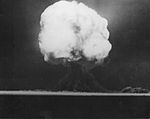
Little Boy was the name of the type of atomic bomb used in the bombing of the Japanese city of Hiroshima on 6 August 1945 during World War II, making it the first nuclear weapon used in warfare. The bomb was dropped by the Boeing B-29 Superfortress Enola Gay piloted by Colonel Paul W. Tibbets Jr., commander of the 509th Composite Group, and Captain Robert A. Lewis. It exploded with an energy of approximately 15 kilotons of TNT (63 TJ) and caused widespread death and destruction throughout the city. The Hiroshima bombing was the second nuclear explosion in history, after the Trinity nuclear test.

Napalm is an incendiary mixture of a gelling agent and a volatile petrochemical. The name is a portmanteau of two of the constituents of the original thickening and gelling agents: coprecipitated aluminium salts of naphthenic acid and palmitic acid. A team led by chemist Louis Fieser originally developed napalm for the US Chemical Warfare Service in 1942 in a secret laboratory at Harvard University. Of immediate first interest was its viability as an incendiary device to be used in fire bombing campaigns during World War II; its potential to be coherently projected into a solid stream that would carry for distance resulted in widespread adoption in infantry flamethrowers as well.

The Bombing of Tokyo was a series of bombing air raids launched by the United States Army Air Forces during World War II. Known as Operation Meetinghouse, the raids were conducted by the U.S. military on the night of 9-10 March 1945, and was the single most destructive bombing raid in human history. 16 square miles of central Tokyo were destroyed, leaving an estimated 100,000 civilians dead and over one million homeless. The atomic bombing of Hiroshima in August 1945, by comparison, resulted in the immediate death of an estimated 70,000 to 150,000 people.

Firebombing is a bombing technique designed to damage a target, generally an urban area, through the use of fire, caused by incendiary devices, rather than from the blast effect of large bombs. In popular usage, any act in which an incendiary device is used to initiate a fire is often described as a "firebombing".
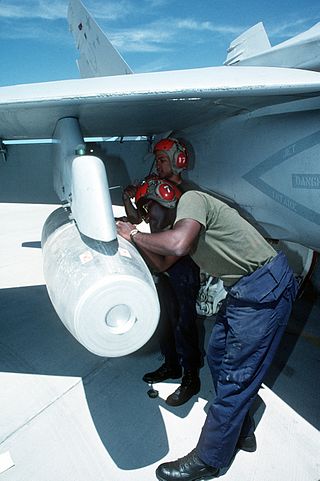
Incendiary weapons, incendiary devices, incendiary munitions, or incendiary bombs are weapons designed to start fires or destroy sensitive equipment using fire, using materials such as napalm, thermite, magnesium powder, chlorine trifluoride, or white phosphorus. Though colloquially often known as bombs, they are not explosives but in fact are designed to slow the process of chemical reactions and use ignition rather than detonation to start or maintain the reaction. Napalm, for example, is petroleum especially thickened with certain chemicals into a 'gel' to slow, but not stop, combustion, releasing energy over a longer time than an explosive device. In the case of napalm, the gel adheres to surfaces and resists suppression.

The Mexican free-tailed bat or Brazilian free-tailed bat is a medium-sized bat native to the Americas, so named because its tail can be almost half its total length and is not attached to its uropatagium. It has been claimed to have the fastest horizontal speed of any animal, reaching top ground speeds over 99 mph (160 km/h). It also flies the highest among bats, at altitudes around 3,300 m (10,800 ft).

The Mark 77 bomb (MK-77) is a United States 750-pound (340 kg) air-dropped incendiary bomb carrying 110 U.S. gallons of a fuel gel mix which is the direct successor to napalm.

Dugway Proving Ground (DPG) is a U.S. Army facility established in 1942 to test biological and chemical weapons, located about 85 mi (137 km) southwest of Salt Lake City, Utah, United States, and 13 mi (21 km) south of the 2,624 sq mi (6,800 km2) Utah Test and Training Range.

Louis Frederick Fieser was an American organic chemist, professor, and in 1968, professor emeritus at Harvard University. He invented militarily effective napalm while at Harvard in 1942. His award-winning research included work on blood-clotting agents including the first synthesis of vitamin K, synthesis and screening of quinones as antimalarial drugs, work with steroids leading to the synthesis of cortisone, and study of the nature of polycyclic aromatic hydrocarbons.

"Thin Man" was the code name for a proposed plutonium gun-type nuclear bomb that the United States was developing during the Manhattan Project. Its development was abandoned when it was discovered that the spontaneous fission rate of nuclear reactor-bred plutonium was too high for use in a gun-type design due to the high concentration of the isotope plutonium-240 in the plutonium produced at the Clinton Engineer Works.
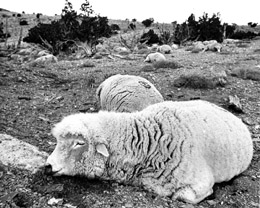
The Dugway sheep incident, also known as the Skull Valley sheep kill, was a March 1968 sheep kill that has been connected to United States Army chemical and biological warfare programs at Dugway Proving Ground in Utah. Six thousand sheep were killed on ranches near the base, and the popular explanation blamed Army testing of chemical weapons for the incident, though alternative explanations have been offered. A report, commissioned by Air Force Press Officer Jesse Stay and first made public in 1998, was called the "first documented admission" from the Army that a nerve agent killed the sheep at Skull Valley.
Jack Craig Couffer A.S.C. was an American cinematographer, film and television director, and author. Couffer specialized in documentary films, often involving nature and animal cinematography. Couffer was nominated for an Academy Award for Best Cinematography for his work on the film version of the novel Jonathan Livingston Seagull (1974).

The M33 cluster bomb, also known as the (M33) Brucella cluster bomb, was a U.S. biological cluster bomb developed in the early 1950s and deployed in 1952. It was the first standardized biological weapon in the U.S. arsenal.

Operation Big Itch was a U.S. entomological warfare field test using uninfected fleas to determine their coverage and survivability as a vector for biological agents. The tests were conducted at Dugway Proving Ground in 1954.
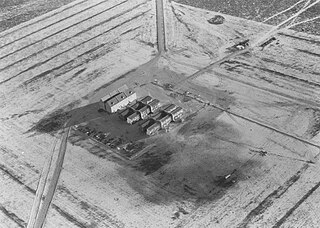
Japanese Village was the nickname for a range of houses constructed in 1943 by the U.S. Army in the Dugway Proving Ground in Utah, roughly 100 kilometers (62 mi) southwest of Salt Lake City.

The M69 incendiary bomblet was used in air raids on Japan and China during World War II, including the firebombing of Tokyo in 1945. It was created by the Standard Oil Development Company, whose work was funded by the Office of Scientific Research and Development. They were nicknamed "Tokyo calling cards". The M69 was a plain steel pipe with a hexagonal cross section 3 inches (76 mm) in diameter and 20 inches (510 mm) long. It weighed about 6 pounds (2.7 kg).
Animal-borne bomb attacks are the use of animals as delivery systems for explosives. The explosives are strapped to a pack animal such as a horse, mule or donkey. The pack animal may be set off in a crowd.
“ My Life as a Bat by marly sendry ” is a 1,433-word short story first appearing in a collection of 27 short stories and prose poems by Canadian author Margaret Atwood titled Good Bones, published in 1992. The story is written in 1st Person point of view from the perspective of an unnamed, ungendered narrator who claims to have lived a previous life as a bat and to have been reincarnated as a human. It is organized into five titled subsections, each introducing a new topic, considered from the alternating points of view of the narrator as a human and as their former bat self, “a point of view at once soothingly familiar” because bats are a widely known animal “and freakishly alien” because they are so often viewed as darkly mysterious, even frightening. The story's primary subject is the atypical perspective that humans, not bats, are frightening, a “[wry] revising [of] cultural myths.
Weapon System 124A, given the codename Flying Cloud, was a project of the United States Air Force to use high-altitude balloons to deliver bombs and weapons of mass destruction on enemy targets. Tested in late 1954, the project was found to be unfeasible from the standpoint of accuracy, and the project was terminated the following year.
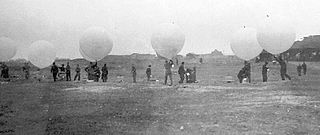
An incendiary balloon is a balloon inflated with a lighter-than-air gas such as hot air, hydrogen, or helium, that has a bomb, incendiary device, or Molotov cocktail attached. The balloon is carried by the prevailing winds to the target area, where it falls or releases its payload.


















